Following the publication of the National Shipbuilding Strategy (NSbS), Babcock has released details on its design for the Type 31e frigate at DSEI this week.
A design the company say is focused on providing a reconfigurable platform, the Babcock Arrowhead 120 design is likely to compete against BMT Group for the Type 31e contract.
Arrowhead’s, ‘adaptable configuration’ acknowledges operational roles will change through the life of the ship with multiple mission bays incorporated into the design allowing for rapid reconfiguration and re-role to meet changing operational needs.
Babcock said they have been advancing operational and data analysis technologies at a rapid pace.
“Arrowhead is cleverly designed to reduce through life costs by embedding key innovations such as real time equipment health monitoring during the build enabling information to be collected during deployment on the fitness of its systems to inform future service and maintenance arrangements.”
With the vessel able to accommodate a variety of equipment choices and with flexibility at the centre of the design philosophy Arrowhead can be deployed for a broad range of roles from low threat security operations to task force deployments.
Babcock say that the Arrowhead design lends itself equally to either a single build strategy, or a cross–site build strategy bringing together modules – an approach used for aircraft carrier assembly at Rosyth.
Craig Lockhart, Managing Director Naval Marine, Babcock said:
“Arrowhead is a game changing general purpose frigate for modern navies. Optimising Through Life Support costs is at the very core of the principles of Arrowhead’s design and build methodology, all balanced against the ability to deliver the required capability.
In focusing Arrowhead’s development around a sustainable and capable design that will help to keep any fleet ‘mission ready’, Babcock has drawn upon its significant experience in vessel design and support for global clients.”
The 120m Arrowhead is an exciting addition to Babcock’s portfolio of ships. The most recent build example being the Samuel Beckett Class OPVs that Babcock is building for the Irish Naval Service at its Appledore facility in North Devon.
The FTSE company has extensive experience in providing critical naval design services, equipment, in-service support and training in the UK as well as in countries such as Australia, Canada, South Korea, Spain and New Zealand.



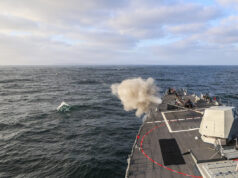
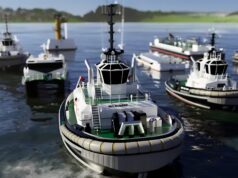
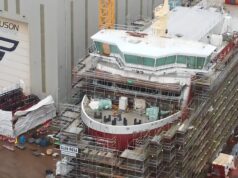
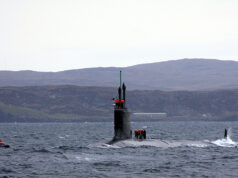
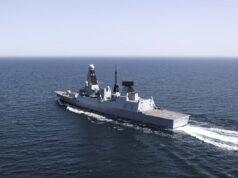

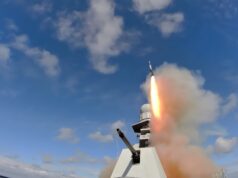
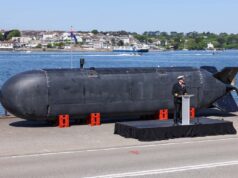
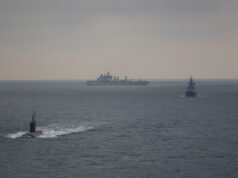
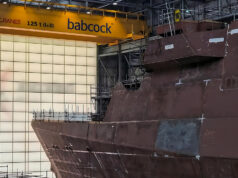

Seems like the marketing team have been busy. Lots of great buzz words, sustainability, flexible, mission ready blah blah blah. However, being positive it does look good and it is not from Bae
Its worth remembering that this is the same size as the current T23’s and with a more modern design and weapons fit out there is nothing to say it won’t be as successful. In reality the T26 is a destroyer.
For the life of me I have no idea why we need chinook capable flight decks on any of these vessels when a merlin can take 22-28 people – Chinooks are for the bigger assets not destroyers and frigates.
A t31 with a wildcat and guns etc will be more than a match for the T23 – especially with CEC onboard. Great news and the more I see this the more I like it – but Spartan still seems to have the better configuration of mission spaces, might be worth pooling resources on this to beat Venator and/or BAE.
It remains to be seen what ASW abilities these will have, if any.
These displays are ‘best available spec’ & not necessarily what can be squeezed into the £250m cap.
I wouldn’t say they are a match for the T23 unless we know what it can do wrt submarines.
Joe – I agree but likewise we can’t say it is an upscaled OPV – My point is that it is remarkably similar in size to a T23 whilst the T26 is almost identical in size to the T45 and people are maybe being a little too critical of this initiative.
Lets give it a go and see what happens – As long as they can take CC4 and have reasonable sound proofing abilities then I will be happy. Remember these are GPF same as 5 of the current T23’s.
All built by eastern Europeans ?
Spartan is my favourite and you are right about the helicopter provision. Wildcat, Sea Ceptor, 5inch gun, One CIWS, Sonar, ASM and some small guns would be fine. I wouldn’t even mind if some of these capabilities were fitted for and not with to keep the build cost down if we could get 10+ of these vessels.
According to the T31 core requirements you will get sea ceptor OR CIWS, not both. No ASM (we can’t afford mk41 VLS) and no containerised ASM are due to replace Harpoon in the RN fleet as far as we know, so the T31 won’t have them. 5″ gun might be too pricey, though it doesn’t make sense to introduce another gun type, so we may get it, or a 30mm….who knows…not looking good so far though
Hopefully we’ll get Sea Ceptor, 5″ gun and box launchers. I don’t think we’ll get Mark 41 in the first batch but I’m hoping that “more money will be available” for the second batch and the budget will be increased.
I really hope the UK Government pulls their finger out and haggles with the US to get LRASM (VLS and box launched) at a reduced price so we can equip our vessels asap.
I think you’re being way too pessimistic Dan.
Re ASM Arrowhead, Spartan and Venator all have explicit provision for 2 x 4 box launchers. You’re right about there being no known-to-the-public plan for replacement of Harpoon for the RN (and very probably no plan at all) but if that were ever to change then any of the designs I mentioned should be able to host something like NSM, LRASM or other box-launched system.
As for point defence, the T31e spec released actually reads “Point Defence Missile System (PDMS) + Sensors or Close in Weapon System + Fit to Receive PDMS” so the “or” bit specifies a ship capable of hosting CIWS + PDMS but with the PDMS potentially fitted FBNW to get within the £250m indicative cost (which doesn’t necessarily equate to the MoD’s budget per ship). That doesn’t preclude a bidder delivering more for the £250m (Sea Ceptor tubes are pretty much drain pipes, certainly way less expensive than any hot-vent system) or the MoD allocating extra budget to put Sea Ceptor in or cross-deck the tubes from the last 5 T23.
Wish I could share your optimism Julian, but all signs are that further cuts are required to balance the books, so I’m not hopeful of getting a great deal more than £250 million per ship. Though I do agree with your point that this price cap is the challenge set, not necessarily the budget that the MoD will be willing to pay, since we don’t know what the T31 total project budget is. It is plausible that they will take the baseline £250 million design and then add additional capabilities as required above that, and be willing to pay a commensurate price to do so. However, I do not share your optimism that this will happen. Indeed, it seems that the cost of £250 million is inclusive of the cost of components taken from the T23’s – this kit will not be a free bonus to add on top of the £250 million design, it will have to be costed in. I think given the budget we will be getting a lot of FFBNW, so we shall (hopefully) see CAMM and then FFBNW CIWS, which much like the RFAs could be added from the phalanx pool when desired. I can’t see any mk41 being affordable, though they will be FFBNW or will be a design option (in the space we use for CAMM, for example) – they just need to be capable of having mk41 for export, not actually be in service on the RN T31. God knows what medium gun we will get because the 5″ seems expensive, the 4.5″ is being phased out and we have no other gun in service above the 30mm. Presumably we will get the hull mounted sonar from the T23 (though this isn’t certain, since it’s inclusion is not a core spec – it needs to be capable to receive one, not actually have one), but I doubt we will get the spare tails from the T23 (and recent T26 purchase). We won’t get torpedo tubes since they are not going onto the T45 or T26, and are being retired with the T23s. We won’t get ASM since we don’t have any in service from next year, merely FFBNW will be sufficient so that they can be included for the export market. Put it all together and what have you got? Can you call it a frigate? an escort? Or just a patrol ship? Hope my pessimism is proven wrong…..
And to continue my pessimism, there is no point getting excited about the Spartan, Venator or Arrowhead designs since there currently advertised configurations for armaments and sensors was prior to the £250 million cap announcement, so we shall see the next iterations of these designs with a lot of FFBNW when they are recalibrated to meet the new budget….
Dan, I think your pessimism may be well founded. To quote the 1st Sea Lord…
“This requires big decisions with far reaching consequences. Are we, for instance, prepared to remove existing platforms from service in order to create the financial and manpower headroom to introduce new systems which, in time, could deliver truly transformative advances in capability?”
We really need to know what existing platforms are going to be removed. Are we saying for example that not renewing Harpoon is paying for some SW-4 Solo rotary UAV’s or are we saying sorry chaps its 57mm and no Sea Ceptor on Type 31 but you get a UAV to spot drug smugglers or a USV mine clearance instead. Would be nice to know.
Fair enough. I’m not going to criticise your view, sadly there is a very significant chance that you’ll end up being right. I was just trying to offer a different potential outcome. As to which is more likely? Well, put it this way – I certainly wouldn’t bet against your view.
I do agree with a lot of what you wrote in your long and considered reply (RFA-like handling of FFBNW Phalanx sometimes supplied from the pool, Mk41 unaffordable for RN but must be in the design for exportability, and huge uncertainty about the gun).
I guess we all just watch and wait together here, hoping for the best but preparing ourselves for the worst.
Spartan comes from a tiny company who designs yachts for a living and the “design” is a brochure with very little detail but really nice graphics.
…run from what looks like the home of one of the employees.
“Arrowhead is cleverly designed to reduce through life costs by embedding key innovations such as real time equipment health monitoring during the build enabling information to be collected during deployment on the fitness of its systems to inform future service and maintenance arrangements.”
Bae fitted a system that does this to the River B2’s.
Yes and their also supposed to install it on the Flight III Burkes. Maybe it will actually work. But it’s made by BAE so it maybe 2mil$ to build a giant toilet down which another 4-5 will be flushed.
Ron, do you think that BAE can produce either Cutlass or Avenger with damage control equal to, or better than, the river batch 2, with say 16 sea cepter, a medium gun, hull sonar, merlin (wild cat + UAV) sized hangar, and Artisan for £250 million?
I believe that the BAE designs are the most mature…given the river batch 2 are coming in at about £120 million, what more could they do for an extra £100 million plus whatever they can use from the decommissioning T23s? Any thoughts?
Remember Dan that the RB2’s are well over priced for what they are and you can get an awful lot for £130m
5″ Gun – £30m
Seaceptor – £20m (16VLS – Quad packed)
Radars – £5m (Artisan)
MTU Torpedoes – £10m
Rolling Air Frame – £2m
Defensive Aids suite – £5m
Helicopter fit out – £10m
Captas C4 Compact – £5m
Combat System – £10m
8 x Canisters (LSRAM?) – £10m
Other items – £20m
I don’t think these costs are too fanciful and actually think they are conservative – so I think we can do it – after all other countries do.
Clearly we need to find money for helicopters etc for these but I think for the cost of the actual ship these are valid, remember we are programmed to accept the high costs published that embed a large portion of support upfront (circa £60%).
Bae can’t win the design competition no matter what they do because it would be an admittance that the new strategy is a failure plus don’t forget that Sir John Parker said in his input: “don’t give the job to Bae”. That “advice” is still in one of the Strategy’s appendices.
I believe that the competition is for Babcocks to lose.
It’s a political project for a political purpose which will be won by politics.
No Mk41 = no export sales. A ship designed to have maximum export value must have this flexible VLS. The main gun should be limited to the Bofors 57mm or the OTO Melara systems. Give the customers exactly what they want to buy. Add a helo hanger, a ciws, a 3D radar and a bow sonar you’re there. You won’t get much more for £250M. Even that may not be feasible.
The picture does seem to have a pair of Phalanx CIWS either end of the hanger.
I’d prefer to see our rivers carrying the OTO76mm to give it at least half a chance in any conflict. War does not respect “police” only vessels, all become targets & we have a duty of care to our sailors.
I’d like to see our QE CVAs equipped with sea ceptor. With so few escorts available they need to be more self-sufficient defensively for such high value assets.
I agree with others that we need a bit more diversity & value for money such as this Babcock design provides over BAe. It may economically make sense to desk accountants to have all escorts made in one yard but militarily it’s madness, inviting any enemy to take out our build capability in one easy strike. So why not Babcock, or Devonport or Portsmouth etc. Over centralisation is a strategic own goal.
Agreed, the original OPV’s where only meant for fisheries protection in the North Atlantic. If they intend to send these to Bahrain they will end up tugged back to a port in Iran so the sailors can be filmed apologising for their illegal incursion intl Iran territorial waters.
If the RN/MoD were to go with the Oto 76mm for the T31 then it might make sense to up-gun the River B2s to 76mm to get the maximum benefit out of introducing a whole new gun system to the RN. Unless that happens then from what Gunbuster and others say about the practicalities of these things I just don’t see it as an option.
If 76mm were to come in though then it would probably also make sense to have it on whatever becomes the new MCM platform assuming it’s some sort of mothership deal such as BMT are proposing with Venari-85. That would leave 5″ on the T26 and ultimately T45 replacement (which might end up being a T26 variant anyway)
It’s very odd, you can see one Phalanx but but not another. Where is it??
Or maybe there is only one in a very strange location.
Yeah. It’s odd isn’t it. The render for this article clearly shows a Phalanx on the starboard side but the first render on the STRN article (http://www.savetheroyalnavy.org/babcock-announces-arrowhead-another-option-for-the-type-31-frigate-competition/) shows a clear view of the port side of the hanger but no Phalanx. The second render on the STRN article shows an overhead view and there one can see weapons stations on top of the port and starboard sides of the rear of the hanger but both are empty (or at least devoid of Phalanx).
On the render for this article, might that be the very top of the second Phalanx that you can see just peeking up over the aft edge of the funnel, just behind the two black aft-facing exhaust vents coming out of the top? The angles look about right.
It’s so frustrating that we’re all having to resort to micro-inspections of renders to work out what’s what, and even then who is to know how much is actual designed-in capability (weight distribution, structural integrity, EM issues, etc all considered) and how much is artistic license. The only saving grace is that, in theory, this design competition and contract award process is on a fairly aggressive timescale.
Another key point about Babcock is they have 3 UK facilities – so can meet the SJP recommendation to share these builds around the country and keep it within house.
BAE have the T26 and Babcock the T31’s and then Cammel and HW can do the Aegir hulls for the RFA and amphibious capability if they can be competitive and we are there.
All non warship building will offshore, UK yards cannot compete with foreign yards.
The tidespring project seems to be successful and well as a bargain for the UK taxpayer.
The UK shipyards will need to work together to produce a combined competitive offer that is cheaper than what is offered internationally.
To build further vessels outside of the UK would be inexcusable.
The three frigate “sheds” in Plymouth are the largest in Europe.
Surely Babcock with their arrowhead design must be clear favourite to win the t31 project, assuming they can meet the price cap.
Over to the MOD let’s hope you get this one right for them service personnel who may one have to risk their lives with this equipment.
I agree, although the vessel will have to be a credible war fighter to make up for the loss in numbers of Type 26. Sea Ceptor and box launchers (NSM/ LRASM) for the first batch of 5. Mark 41 VLS for the rest.
Looks like Babcock is keenly pitching to the US market (https://news.usni.org/2017/09/13/dsei-royal-navy-wants-pitch-type-31e-frigate-design-u-s-export-market) what with their USCG experience an’ all. The article shines light on the flight deck (V22 capable) and hangar (Seahawk capable) size, which better fits the specs than the RN as the Merlin won’t fit in the hangar.
If they think they have a sniff at that project they might well put in a bid for the RN that really tries to squeeze as much capability into the £250m. As industry input is going to be key to the success of the T31 for the RN, the more Babcock believe they can win big export orders the better for the RN. Whether it works or not is another question. I see Babcock are also looking to expand into diesel-electric submarines, so they’re looking pretty ambitious at the moment. Good luck to them.
They are really looking like leading contenders for T31 at the moment for me: (1) as they appear super-keen (see above); and (2) as they have their own dockyard; BMT and Steller (if they’re serious) don’t and will have to negotiate with CL, H&W, Babcock or BAE to come up with a bid making it that bit harder.
If they are trying to really pitch it to the US. Then the flight deck was made so large likely for the Super Stallion and the newer King Stallion heavy lifters. The USN and USMC use those for moving things like necessary parts for the ships and CAW in addition to ships themselves. In addition to their deep deployment role.
Another reason Babcock is probably keen to enter the FFG competition. Is the US is looking for a supplier or at the least a designer for an order of diesel submarines. To fill the Taiwanese Navy requirement. No yards in the US have a design for one because the US hasn’t use one since the late 70s.
Website “Naval Recognition” have pictures of a scale model of an enlarged LCS Freedom class from DSEI. I wonder how much these will be offered to the US Navy for compared to the existing LCS-Freedom class and a Babcock Arrowhead with 16 Mark 41 VLS. Interesting times.
The way I see it anyone but Bae has to good. Babcock and BMT are a breath of fresh air with there inovative designs.
You can wish for ever what you want to see on the hulls but you can bet it will be the bare minimum. Reducing costs on the ship design is great but I bet that goes with reduced costs on armaments. You’ll end up with a lovely vessel which can do Jack s___t .
Tru dat
I the choice is between the Babcock design and Venator. Babcock have construction credibility and speak with authority on ongoing support costs. And their design looks a tad larger than Venator. Venator looks to have the edge on modular assembly and seems well thought through in respect of armament options for patrol ship, patrol frigate and light frigate which is very supportive of the NSS amd exports. Babcock Arrowhead is probably a close relative of the Vard design for the USCG offshore cutter so Babcock will hope to leverage the US connection and maybe economies of scale…RR diesels, 57mm….
Looking forward to the design selection. Actually I think even BAe Cutlass could be a contender if BAe really put the effort into modular construction ( in competitor’s yards) and aggressive price reduction. Where there’s a will there’s a way….
Commission them, run them for a short time and flog them, that’s the plan.
BAe can’t win this competition because they have been seen to be ripping off the pubic purse. Remember the pubic sector are perfect and the MOD are a model customer; always knowing what they want, never changing their mind and providing a steady flow of orders so a business can plan ahead with confidence in the long term.
Somewhere in the middle of this is the reality and whilst HMG is useless and should never have allowed a single source arrangement to develop BAe took full advantage. So the Type 31 has to be built by anyone other than BAe to recreate some competition but long term without sufficient orders two UK ship builders are not viable. We can only hope that a more enlightened Government will perhaps slightly increase the size of the RN to help the two builders flourish and possibly exporting some ships.
Here is the truth, my son in the RN said it would eventually leak out:
Royal Navy a ‘laughing stock’ with three quarters of its warships out of action and ‘struggling to protect British citizens’
Currently 13 of the Navy’s 19-strong fleet of Type 23 frigates and Type 45 destroyers are unable to go to sea due to a lack of manpower, fuel and supplies, senior military sources have revealed.
The cuts to defence spending have also severely hampered Britain’s response to Hurricane Irma.
HMS Ocean, the amphibious assault ship that currently serves as the Royal Navy’s flagship, was sent to provide support to the British overseas territories in the Caribbean but suffered engine problems and has now been delayed by a week.
http://www.telegraph.co.uk/news/2017/09/14/royal-navy-laughing-stock-three-quarters-warships-action-struggling/
If this is true then where are the Senior Officers coming out and informing the country. They would be applauded for doing it.
Pessimism abounds – and given fairly recent history, not without reason. However, the fact that the NSS has been accepted in government may mean the tide is at least veering in the RN’s favour. The latest ‘hints’ are that the Navy share of cuts will be 2-3 MCM, with F35B procurement capped at around 70 to enable CEPP. Overall budget for Type 31 has apparently been set at 2bn, so in theory 8 ships. However 250m each seems doable, as the only ‘new fit’ weapon would be the main gun (127mm for shore bombardment ?) SeaCeptor comes from a common pool, 30mm guns, Artisan radar, Phalanx CIWS etc are either in storage or recycled from retiring Type 23’s so will not be part of the tender price, possibly other than installation costs. Given that 3 ‘ship sets’ of equipment are to be acquired for the 3 initial Type 26 to avoid early retirements, this would leave all 13 ex Type 23 equipment fits for re use (5 future Type 26, 8 Type 31) which could even include 2050 sonar sets! The numbers add up! Too coincidental to be true……?
@Steve R
You miss the point flagged in the Telegraph article in Alan Jarvis’s posting.
Of 19 escort ships, 6 are operational. The rest are rusting away.
The game is up. Reality dawns. The UK is broke. Cuts across the board are coming despite the political waffle,
TH – as a supposed representative of the taxpayers alliance you should at least try and present facts accurately.
The UK is not broke, we are one of the wealthiest countries on the planet by any measure and are able to fund a wide range of public services if we choose.
It is a fact that times are challenging, but the government of the day has decided on a course of action, it is therefore a choice as to which budgets are impacted.
There is massive waste in all public services and the MOD are no different. Suggest you stop sensationalising a dept trying to stay within its budget whilst its task masters expect it to do more.
At the very least you should give those who serve in our military the same sort of respect you probably reserve for those who work in the NHS, as they really do plan themselves in danger for our freedom.
TH – Non of what you are saying is factually correct in support of the UK being broke. They are choices being made by political and military leadership.
look around you – the country is significantly richer than it was 50 years ago – almost unrecognisable.
Our GDP is good, our public services are world class and our response to Irma has been better than the US and France (who we are helping).
Are things perfect – no. but we are not broke – no where near it.
We are a laughing stock – and that is a pity, but again that is politicians saying one thing to coroners, committees, judges and the public and doing another thing entirely (i.e.: snatch LR).
You are conflating several issues to support a personal argument and using journalists opinions to support this.
The Politicians can change the manpower of the Military tomorrow if they wish to – they do not – simple.
Mindlessly repeating the same idiocy over and over again does not make it fact.
The Black Hole in the defense budget as you put it only exists because of people unwilling to make the financial sacrifices for national defense. The solution is emphatically NOT more cuts but to raise the budget as necessary. Then hang whoever is responsible for letting readiness decline to this point. Because if someone hasn’t died due to this state and often lack of equipment and manpower they soon will. Currently the political establishment is insulated by the fact conflicts are far from home. But sooner or later if cuts like this continue they will be forced to reap the whirlwind.
Here Here Elliott. Sir Michael Fallon is now on record stating that our armed forces will be provided with the right equipment for the job – this also must include at the appropriate volumes.
It is a shame on this nation that we do not value our armed forces, teachers, nurses, doctors, police and other services in the same way as other countries do.
In the case of the UKAF’s this needs to be addressed as a matter of urgency.
Just watched a very interesting video reporting from DSEI where they interview Babcock, BMT, Steller Systems and Lockheed Martin:
https://www.youtube.com/watch?v=8_IW7TkptJQ
Babcock say the Arrowhead is “..not designed to meet shock standards” and “…capable enough to put it in a war fighting role but not as a front line combatant”.
Got the impression watching the video that Spartan was a warship, Arrowhead was the USCG cutter ( I can shoot but please don’t shoot back) and Venator was all things to all men. Would be a turn up for book if Cutlass turned out to be the toughest combattant.
To the contrary, Mr Jarvis has the facts entirely wrong. The current tempo of RN escorts is detailed in an info graphic, see ‘Save the Royal Navy’ http://twitter.com/haynesdeborah for details. If Mr Jarvis would just check information before copying the same sensationalist newspaper rubbish he might be better served. He starts by quoting his ‘son in the Royal Navy’ as if he has the inside track, but obviously not! Indeed, in a different thread, he claims that the delay in despatching HMS Ocean to the Caribbean was because she had broken down when in actual fact she was withdrawn from other commitments and is now on her way after taking on stores at Gibraltar. I would advise him (and you) not to take every newspaper article as gospel.
A Smith
Very interesting, not least because of the proposed cooperation between Babcock and BMT, probably the two leading contenders! The process is obviously at a (relatively) early point, and issues such as shock resistance, for which the RN has strict standards following the Falklands, will surely be brought to an acceptable level. Note however that ‘damage control and survivability’ are emphasised…..sounds contradictory, highlighting one aspect over the other as they are surely complimentary?
Yes, I was amazed to hear from BMT that they were working on the Venator with Babcock whilst also acknowledging Babcock’s competing design for the Type 31e.
The video raises the following questions:
(i) How can Babcock say that the Arrowhead is “..not designed to meet shock standards” and yet put their ship forward for the US Navy FFG(X) when the RFI states:
“Grade A Shock Hardening for Propulsion, Critical Systems, and Combat System Elements to retain full Air Defense and Propulsion Capabilities”
(ii) Say the Arrowhead is “…capable enough to put it in a war fighting role but not as a front line combatant”. Isn’t the Type 31e supposed to be the Type 26 but not at a Type 26 price?
Is the Type 31e going to turn up to a war zone but never use it’s weapons?
(iii) How can BMT collaborate with Babcock when Babcock are submitting a competing design?
What this says to me is that Babcock will benefit from this competition one way or another.
Wouldn’t surprise me at all if the two merged their bid, with a sort of hybrid of the designs. Shame, as a level of competition would be removed. Your other points are fairly made, perhaps they are referring to the current state of design, rather than the more mature level which will be required when going to tender. Babcock do seem to be in the drivers seat, but options to build are a bit limited, and the MOD still seems to be favouring the block build route.
The RFI asks for info on whole life costs, training and support models. BMT would help from Babcock for these sections of a Venator bid. Equally I suspect the Venator design is better in terms of modular build and adaptability. Be interesting to see if both designs end up being submitted. A joint bid would have a lot of credibility.
Here’s some breaking news for you all…..
The Government published the RFI for the Type 31e yesterday:
https://www.gov.uk/government/publications/request-for-information-to-support-type-31e-market-testing
Kudos to the MOD. To my layman’s eyes very clearly stated. Its over to industry now.
Kudos to A.Smith too. Good spot. Thanks for posting.
A couple of things that caught my eye…
Page 3 – “Accept a firm price contract for a first order of five ships;”
If nothing changes that looks as if the MoD might not play silly tricks and order 1 or 2 at a time but actually commit to a batch of 5 up front.
Page 12 – “£250M is the maximum average price per ship for an initial order of 5 ships. … All costs are at outturn assuming an in service date with the Royal Navy for the first of class of 2023, and a drumbeat of a ship delivered every 12 months thereafter;”.
An explicit reference to a drumbeat of one per year will be music to Pacman27’s ears (and others).
With those two statements above, a firm fixed price initial order and an aggressive drumbeat declared, does seem to indicate that some past mistakes have been learned from. It still all comes down to how much can be got for the money though.
Everyone please remember that the T26 cost includes 10years worth of support and maintenance as well as infrastructure for new equipment. My analysis would suggest these cost normally account for 60% of the total price which means the cost of actually building a T26 is closer to £500m than £1.2bn. Of course I could be wrong but it seems to me that the MOD scares all potential bidders away by this destructive cost model.
If the T26 comes in around £600m to build then it is frankly a bargain. I for one cant see how it can be that much more expensive given our current efficiency with carriers etc.
There is a window of opportunity here – but it is running out
Btw: the same cost model for T31 will probably mean a published cost nearer £600m each than £250m. So we need to treat these costs with a fair pinch of salt I am afraid.
Have I read this RFI correctly – 10-15 year lifespan?
Then they get sold on. Seems HM Govt have understood and accepted Sir John Parker’s argument in the shipbuilding strategy that we need to move the cost base away from maintenance and support towards new build and exports. Maybe why Babcock are entertaining a joint bid with BMT . Their current business model would need to follow that same direction. Most of their income is from support and maintenance. This is one they have to win.
That being said, there’s nothing wrong with keeping more ‘mature’ ships in service, as long as they are kept ‘current ‘ and a steady drum beat of new builds is in place to sustain the industry i.e. Steady, gradual replacement. The USA, France, Italy, Japan etc – and especially Russia – all have platforms dating from the 80’s (even 70’s) Boom and Bust is the cycle that needs to be broken – as we learned to our cost with Astute. A major problem with this is the 5 year general election cycle and its affect on changing government priorities, which is why long tern Defence projects need an ‘all – party’ approach.
couldn’t agree more Steve
The Defence budget should be overseen by a cross party defence committee and pegged at 2.5% of GDP. It should also be very clear what is included in the 2.5% figure. This would then provide some semblance of balance and continuity to budget and the minister for defence and senior leadership would be accountable to this committee for defence procurement, HR, families, veteran services etc and funding.
Not day to day management and deployment decisions, then we have the balance between capability and funding to ensure our aspirations are properly funded.
It should be said that the 2.5% should be to meet a set of standing commitments and any additional capability required by a particular government would need to be funded in addition to this. I think this is the fairest and most transparent way of doing this.
Too right, and what about Trident? The cost, year on year over the life of the programme may not seem like a huge chunk of the budget, but the deterrent has never had any military value, and as a political tool has no place in Defence. Historically the treasury has funded deterrence independently, and acquisition cost at least should continue to be so. If Trident is included, a case should be made for 2.75% GDP, with a further clear definition of ‘Security’ which, while of paramount importance, needs its own, independent budget.